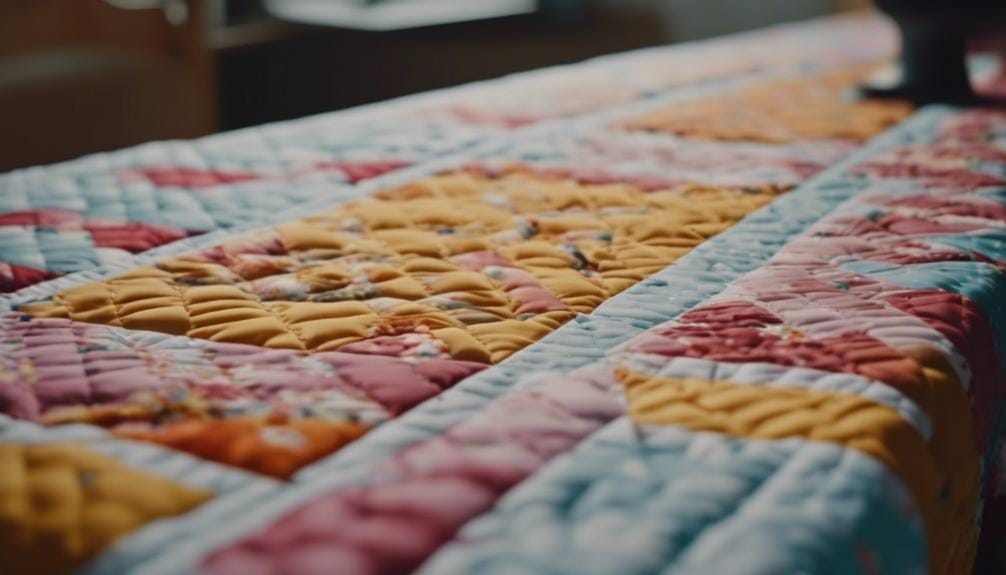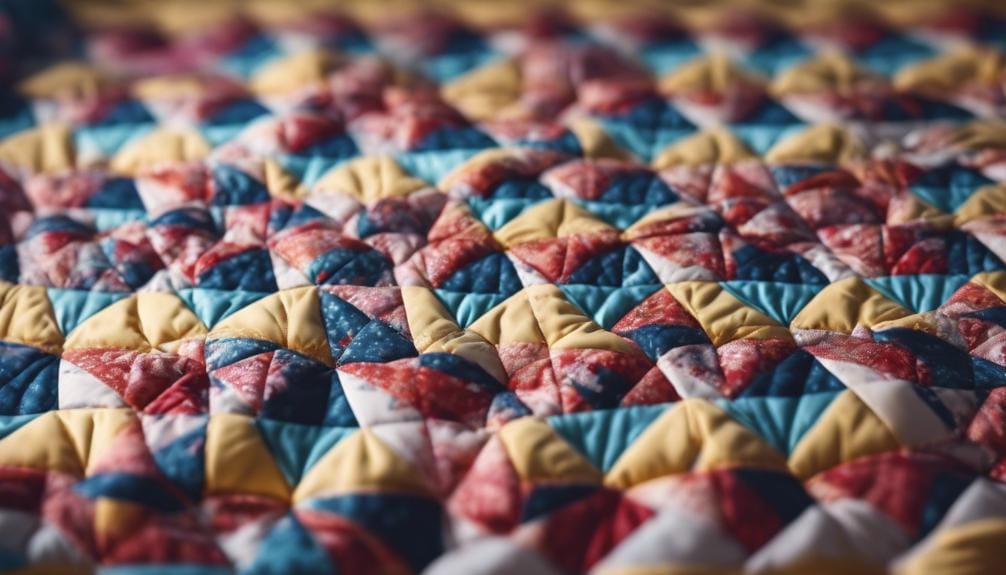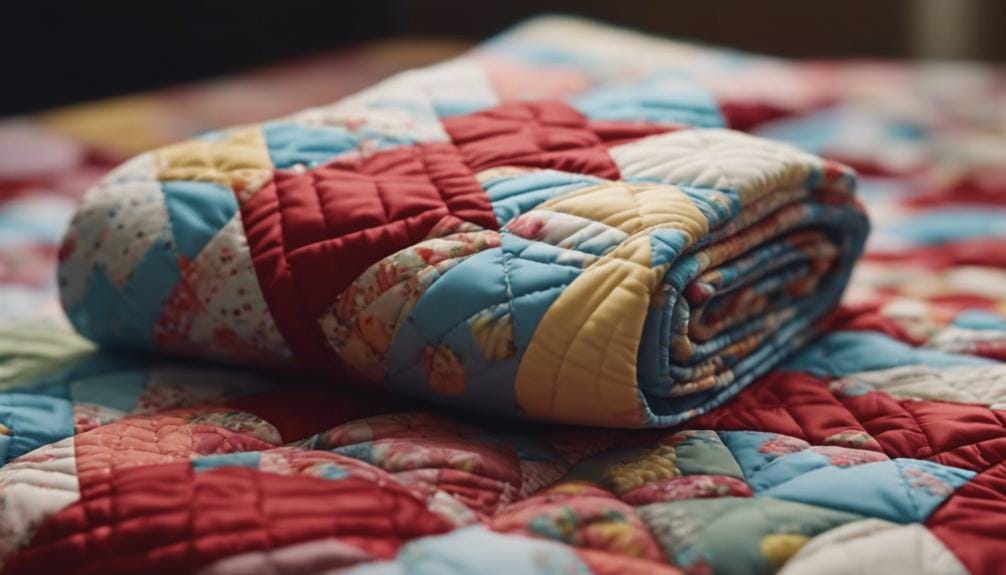How to Fold a Quilt: Preserving Quality & Space
When it comes to properly storing your beloved quilt, you might want to contemplate a meticulous folding technique that not only saves space but also preserves the quilt’s quality for years to come.
It all begins with laying your quilt on a flat surface, but what follows is a precise sequence of steps that guarantee every fold is just right. By the end of this process, you’ll have a neatly folded quilt that’s ready for storage.
But what’s the secret behind this method, and why is it so essential for maintaining your quilt’s longevity?
Key Takeaways
- Folding quilts on the bias preserves structure and durability.
- Tuck folding ensures neatness and smooth finish.
- Proper folding techniques maintain quilt integrity and quality.
- Diagonal folding for storage prevents creases and damage, ensuring longevity.
Benefits of Folding Quilts on the Bias

Folding your quilt on the bias offers numerous advantages for maintaining its structure and durability over time.
When you fold a quilt along the bias, it reduces the risk of permanent creases that can weaken the fabric and batting.
Unlike creases on straight grains that may lead to tears and holes in the quilt, bias folding is a preferred method as it’s more forgiving.
The fabric stretches more on the bias, allowing it to withstand the folding process better without causing damage.
Step-by-Step Guide to Folding a Quilt

To maintain the structural integrity of your quilt and guarantee its longevity, follow these step-by-step instructions for properly folding it. When folding a quilt, especially for storage, using the bias method can help prevent permanent creases and fiber breakage over time. Here is a detailed guide to folding your quilt correctly:
| Step | Instructions |
|---|---|
| 1 | Lay the quilt flat on a clean surface. |
| 2 | Fold the bottom corners towards the center diagonally. |
| 3 | Fold the sides towards the center diagonally. |
| 4 | Repeat the process by folding on the bias to create an envelope shape. |
| 5 | For smaller storage, fold the quilt bundle parallel to previous fold lines. |
| 6 | Store your quilts in a temperature-controlled space to avoid damage. |
| 7 | Regularly re-fold your quilts to prevent creases from setting in. |
Tips for Tuck Folding a Quilt

For a sleek and efficient way to package your quilts, consider mastering the technique of tuck folding. Tuck folding is an excellent method for storing multiple quilts efficiently, allowing for easy transportation and enhancing the overall visual appeal of your quilts.
To tuck fold a quilt, start by laying the quilt flat on a clean, spacious surface like a bed or couch. Smooth out any wrinkles to guarantee a neat finish. Next, fold one side of the quilt towards the center, making sure the edges are aligned evenly.
Then, fold the other side towards the center, slightly overlapping the first fold. This overlapping technique helps prevent creases that could weaken the fabric over time. Gently pat down the quilt to ensure a smooth finish.
Once both sides are folded in, fold the bottom of the quilt up towards the top, creating a neat rectangular shape. Be mindful of the bias stretches in the fabric and try to avoid stretching it too much during the folding process.
Proper Techniques for Folding & Storing Quilts

To properly preserve and maintain your quilts, employing correct techniques for folding and storing is key. When it comes to folding your quilt, start by laying it flat on a bed. Fold one side of the quilt towards the center, making sure to align the corner of the quilt. This helps prevent stretching and is much gentler on the fabric compared to folding along the straight of grain.
Next, fold the other side in the same manner, making certain that the corners meet neatly. Avoid creating sharp creases by gently smoothing out the fabric as you fold. If your quilt is large, you may need to enlist someone’s help to make the process easier.
For storing your quilt, laying it flat on a bed or surface is ideal. This helps distribute the weight evenly and prevents unnecessary strain on the seams. If you prefer to store your quilt vertically, consider folding it on the bias. This technique can help maintain the quilt’s shape and integrity over time.
Importance of Diagonal Folding for Quilt Storage

When storing your quilts for long-term preservation, consider the importance of employing diagonal folding techniques to maintain their structural integrity and aesthetic appeal. Diagonal folding plays an essential role in preserving quilt integrity and ensuring they remain in top condition for years to come. Here’s why diagonal folding is critical for quilt storage:
- Preserving Quilt Integrity: Folding quilts on the diagonal reduces stress on the seams, helping to preserve the quilt’s structural integrity over time.
- Space-Saving Storage: Diagonal folding saves space in storage while maintaining the quilt’s aesthetic appeal, making it a practical and efficient storage solution.
- Long-Term Storage: This technique is recommended for long-term storage as it helps prevent creases and damage to the quilt fabric.
- Prevent Quilt Fabric Damage: By utilizing diagonal folding, you can prevent unnecessary damage to the quilt fabric that may occur with improper storage methods.
- Ensure Quilt Longevity and Quality: Following the diagonal folding method ensures that your quilts are stored efficiently and safely, guaranteeing their longevity and quality over time.
Frequently Asked Questions
What Is the Best Way to Fold a Quilt?
To fold a quilt effectively, start by laying it flat. Bring one corner diagonally to the opposite corner to create a triangle. Repeat for the other side. Fold the sides inwards for a neat, stress-free storage solution.
How Do You Pack Quilts for Storage?
To pack quilts for storage, fold them on the bias, use cloth bags for protection, avoid plastic containers, add acid-free tissue paper, and store in a cool, dry, dark place. Follow these steps to keep quilts safe and well-maintained.
How Do You Fold a Quilt Into a Bed?
To fold a quilt onto a bed, lay it flat, smooth out wrinkles, fold it in half lengthwise, align corners with bed edges, and tuck it neatly under pillows or along the sides. This creates a tidy and symmetrical presentation.
How Do You Store Quilts When Not in Use?
When not in use, store quilts flat or folded on the bias to maintain fabric integrity. Utilize linen closets, cabinets, or quilt ladders for storage. Protect from sunlight and humidity. Rotate and refold every 2 years. Use cloth bags for seasonal storage.
Conclusion
Now that you have learned the proper technique for folding a quilt on the bias, you can guarantee that your quilt stays in top condition for years to come.
Remember to follow the step-by-step guide and use the tips provided to make the folding process smooth and easy.
By folding your quilt correctly, you can maintain its structural integrity and prevent any damage or creases that may occur with improper storage.
Happy quilting!
